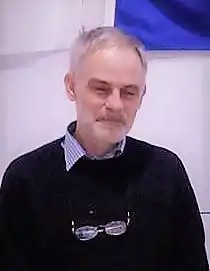Uwe Rau
Uwe Rau is a German physicist that made important contributions to the physics of the photovoltaic device, notably on explaining energy losses in thin-film solar cells and on the use of the reciprocity principle to characterize solar cells by electroluminescence techniques. This led to the development of this technique as a standard in research and industry.

Career
Rau studied physics at the University of Tübingen, Germany, and the Université Claude Bernard, Lyon.[1] Both his diploma thesis (1987) and his doctoral thesis (1991) were obtained for work performed in the group of Huebener, at the University of Tübingen, on the breakdown of Germanium under high magnetic fields, and for non-linear charge transport in semiconductors. He then moved to the Max Planck Institute for Solid State Physics in Stuttgart, where he first did work on crystalline silicon solar cells. In 1995, he moved to Bayreuth where he worked dominantly on the device physics of Cu(In,Ga)Se2 solar cells. 1997, he moved back to Stuttgart to work at the University of Stuttgart, Institute of Physical Electronics, which was led by Jürgen Werner. In Stuttgart, he continued work on Si and Cu(In,Ga)Se2, but also started work on dye-sensitized solar cells, organic solar cells, and the fundamental aspects of luminescence in solar cells. In 2002, he obtained his habilitation from the University of Oldenburg, Germany, for work on the electrical transport properties of semiconductors and interfaces for photovoltaics. Since 2007, Rau is a full professor at the RWTH Aachen and Director of the Institute for Energy and Climate Research at the Forschungszentrum Jülich.[2][3] Since 2011, he is in addition, the scientific director of the HITEC graduate school at the Forschungszentrum Jülich. Currently, he is the director of the JARA-Energy, (JARA = Jülich-Aachen Research Alliance) which coordinates research at Forschungszentrum Jülich and RWTH Aachen in the field of renewable energy.[4]
Achievements
Rau is well known for his various contributions to the basic principles of photovoltaic energy conversion and to improving the understanding of solar cell device physics. Most notable, perhaps, is his publication in 2007 of a paper on a "reciprocity relation between photovoltaic quantum efficiency and electroluminescent emission of solar cells".[5] This work uses the principle of detailed balance to derive basic relationships between the photovoltaic and the light-emitting mode of a semiconductor diode. This work had substantial influence on the field of characterizing solar cells or modules using luminescence-based techniques. In addition, it has provided a framework for analyzing voltage losses at the open circuit in solar cells.[6] Uwe Rau also contributed towards the analysis of thin film solar cells,[7] with seminal papers on the ideality factor,[8] on metastability of the electronic conduction in Cu(In,Ga)Se2,[9] on photovoltaic device stability and self-healing,[10] and on the passivation of grain boundaries in polycrystalline thin film solar cells.[11] He also contributed to several important papers to understand the conversion efficiency limitations of solar cells, among which the role of disorder and potential fluctuations,[12] and on the impact of light trapping on the Voc of solar cells.[13]
References
- "Uwe RAU - European Forum Alpbach". Hitec-graduate-school.de. Retrieved 8 October 2018.
- Burggräf, Volker (10 September 2018). "Pressedienst". Presse.uni-oldenburg.de. Retrieved 8 October 2018.
- publisher. "Forschungszentrum Jülich - Mitarbeiter - Prof. Dr. Uwe Rau". Fz-juelich.de. Retrieved 8 October 2018.
- "U. Rau CV" (PDF). Retrieved 19 September 2018.
- Uwe Rau (2007). "Reciprocity relation between photovoltaic quantum efficiency and electroluminescent emission of solar cells". Physical Review B. 76 (8): 085303. Bibcode:2007PhRvB..76h5303R. doi:10.1103/PhysRevB.76.085303.
- U. Rau, B. Blank, TCM Müller, T. Kirchartz (2017). "Efficiency Potential of Photovoltaic Materials and Devices Unveiled by Detailed Balance Analysis". Physical Review Applied. 7 (4): 044016. Bibcode:2017PhRvP...7d4016R. doi:10.1103/PhysRevApplied.7.044016. S2CID 73656297.CS1 maint: multiple names: authors list (link)
- U. Rau and HW Schock (1999). "Electronic properties of Cu(In,Ga)Se2 heterojunction solar cells–recent achievements, current understanding, and future challenges". Applied Physics A. 69 (2): 131–147. Bibcode:1999ApPhA..69..131R. doi:10.1007/s003390050984. S2CID 93291785.
- Uwe Rau (1998). "Tunneling-enhanced recombination in Cu(In,Ga)Se2 heterojunction solar cells". Applied Physics Letters. 74: 111–113. doi:10.1063/1.122967.
- U. Rau; et al. (1998). "Persistent photoconductivity in Cu(In,Ga)Se2 heterojunctions and thin films prepared by sequential deposition". Applied Physics Letters. 73 (2): 223–225. Bibcode:1998ApPhL..73..223R. doi:10.1063/1.121762.
- Jean‐François Guillemoles, Uwe Rau, Leeor Kronik, Hans‐Werner Schock, and David Cahen (1999). "Cu (In,Ga) Se2 Solar Cells: Device Stability Based on Chemical Flexibility". Advanced Materials. 11 (11): 957–961. doi:10.1002/(sici)1521-4095(199908)11:11<957::aid-adma957>3.0.co;2-1.CS1 maint: multiple names: authors list (link)
- U.Rau; et al. (2009). "Grain boundaries in Cu(In, Ga)(Se, S)2 thin-film solar cells". Applied Physics A. 96 (1): 221–234. Bibcode:2009ApPhA..96..221R. doi:10.1007/s00339-008-4978-0. S2CID 96101400.
- U. Rau and JH Werner (2003). "Radiative efficiency limits of solar cells with lateral band-gap fluctuations". Applied Physics Letters. 84 (19): 3735–3737. doi:10.1063/1.1737071.
- U. Raua and T. Kirchartz (2014). "On the thermodynamics of light trapping in solar cells". Nature Materials. 13 (2): 103–104. Bibcode:2014NatMa..13..103R. doi:10.1038/nmat3837. PMID 24452342.